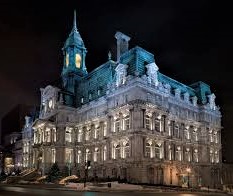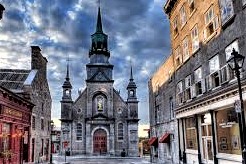Old Montreal is the most seasoned region in the city of Montreal, Quebec, Canada, with a couple of remains going back to New France. Situated in the precinct of Ville-Marie, the zone is verged on the west by McGill St., on the north by Ruelle des Fortresses, on the east by mourn Holy person André and on the south by the Holy person Lawrence Waterway. Following late corrections, the locale has been extended somewhat to incorporate the lament des Soeurs Grises in the west, Holy person Antoine St. in the north and Holy person Hubert Road in the east. It additionally incorporates the Old Port of Montreal. A large portion of Old Montreal was pronounced an architecturally significant area in 1964 by the Ministère des Affaires culturelles du Québec.
HISTORY
In 1605 Samuel de Champlain set up a hide exchanging post at Place Royale, at the intersection of the Holy person Lawrence Stream and the since quite a while ago vanished Petite Rivière St-Pierre, adjoining present-day Place D'Youville and the Pointe-à-Callière Exhibition hall. In any case, the nearby Iroquois effectively protected their territory and the French relinquished their post.
The first site of Montreal in 1642, at that point known as Ville-Marie, is exactly known. This is the Pointe-à-Callière, a real estate parcel at the intersection of the St. Lawrence Stream and Little Waterway. The originator, Paul Chomedey de Maisonneuve, constructed a fortification in 1643 called Société Notre-Lady de Montréal for the change of the Indians in New France. The organization was made by the Sulpician Jean-Jacques Olier and by Jérôme Le Royer (Sieur de La Dauversière) in 1642. The Société gained sway over the island of Montreal and conveyed the main pilgrims to house, bolster, instruct and tend to the Amerindians. Due to flooding, they needed to cross to the opposite side of Little Waterway on the north shore where the Soeurs hospitalières of Montreal (under the course of Jeanne Mance) manufactured and worked the principal doctor's facility.
Canada turned into an English province in 1763 after the French and Indian War. English lead would profoundly change the substance of Old Montreal. Until the late eighteenth century the effect was not obvious, as development to the development of fortresses caused numerous flames, and fires have reconfigured Old Montreal. The flames of 1765 and 1768 annihilated almost a large portion of the structures in the old city. In May 1765, fire crushed around 110 houses previously annihilating the old Hôtel de Callière and the previous General Healing center. In April 1768, 88 houses between lament Holy person Jean-Baptiste and Inn Vaudreuil were singed, including the Gathering Notre-Lady religious circle. In following years, the city was to be revamped considerably more thickly.
On 6 June 1803 a huge fire decimated the jail, the congregation and the conditions of Jesuits, twelve houses and the Château Vaudreuil. Two theorists purchased the Château's patio nurseries, offered 33% to the city, and separated the rest into seven bunches of their own. The city's most seasoned landmark, Nelson's Section, was raised in 1809 on the land given to the city. This space turned into the new market square, called Marché Neuf (New Market) before accepting its present name of Place Jacques-Cartier in 1845. The space possessed by the congregation of the Jesuits turned into the Place Vauquelin, and Montreal City Corridor emerged from the old Jesuit gardens in 1873.
In 1812 a fire crushed the Chateau House, an extravagant inn mainstream with the Beaver Club and which had housed the principal open library in Montreal (with more than 7,000 volumes). It was supplanted by the English American Lodging, with the city's first lasting theater (the Illustrious Venue worked by John Molson, which was gone by Charles Dickens). The lodging consumed in 1833, and was remade in 1845 at the Bonsecours Market. In 1849, a mob caused a fire with political results while, challenging a law, a Tory swarm torched the Parliament working in the old Marché Holy person Anne on Place d'Youville. Amusingly, the site of the Parliament fire housed Montreal's first fire station in 1903; the building still exists as the Inside d'histoire de Montréal.
Frontier experts settled on the main radical change of the territory in 1804, with the obliteration of the strongholds encompassing the core of Montreal. Finished in 1815, this amplified the border of Old Montreal and enhanced access to rural groups. Control in a sustained and exceptionally thick territory inclined to flames made the progressive takeoff of the wealthier shippers what might end up known as the Brilliant Square Mile, where they constructed roomy bequests.
The nineteenth century saw the rise of a bourgeoisie of for the most part Scottish dealers. The developing action of the port changed the urban scene. Old Montreal turned out to be less private, as the rich Scottish and English vendors constructed luxurious homes nearer to Mont Imperial in what might turn into the Brilliant Square Mile. Anglophone impact turned into the ruling power in the zones of saving money, assembling, business, and fund. St. James Road turned into the monetary focus of Montreal, with expansive banks, for example, the Bank of Montreal and the Illustrious Bank, insurance agencies and the stock trade.
The vast majority of the money related structures on St. James Road were planned by anglophone modelers. The same is valid for institutional structures, for example, the Old Court House (John Ostell), the Traditions House (John Ostell), the Bonsecours Market and even the Notre-Lady Basilica (whose façade is crafted by an Irish Protestant from New York, James O'Donnell). The main outstanding special case is the Montreal City Lobby, which was propelled by the Lodging de Ville de Rennes. The character of the Victorian style of the late-nineteenth century structures was a huge change from the stone brick work utilized amid French time, and influenced the presence of Old Montreal.
After the insolvency of the Société Notre-Woman, the Sulpicians (who touched base in 1657) progressed toward becoming in 1663 the Seigneurs of Montreal as Louis XIV took individual control over the state. The new framework gave them the island of Montreal, with the commitment to live there and guarantee its improvement by developing the land. In 1665 the lord sent 1,200 men, the Régiment de Carignan-Salières. The Sulpicians sorted out seigneuries at the focal point of the island. François Dollier Casson set up the main lattice of roads in the settlement, from existing trails. These early boulevards incorporated the Regret Notre-Lady, the Mourn Holy person Paul and Lament Holy person Jacques; the first framework stays obvious starting at 2014. Structures of the time incorporate the Hôtel-Dieu de Montréal, the Holy person Sulpice Old Theological college and Notre Woman Church.
In the mid eighteenth century, the name of Montreal (which initially alluded to the mountain Mont-Illustrious) step by step supplanted that of Ville-Marie. It had turned into a run of the mill French province, in which the underlying dream to consolidate the pilgrims and Local Americans had vanished. The landing in 1657 of Marguerite Bourgeoys (who established the Assembly Notre-Lady), and the entry of the Jesuits and Recollets in 1692, guaranteed the Catholic character of the settlement.
The first fortresses of Montreal, raised in 1717 by Gaspard Chaussegros de Léry, shaped the limits of Montreal at the time. De Léry had the fortresses built so as to secure the settlement from an English attack and to permit future extension inside the dividers. In spite of the fact that the dividers may have given security from attack, they prompted an alternate issue; a huge convergence of wooden houses (with chimneys) prompted numerous staggering flames. In 1721, Montreal got a regal request from France to boycott wood development; structures were to be built utilizing stone, yet the boycott was never completely regarded.















No comments:
Post a Comment